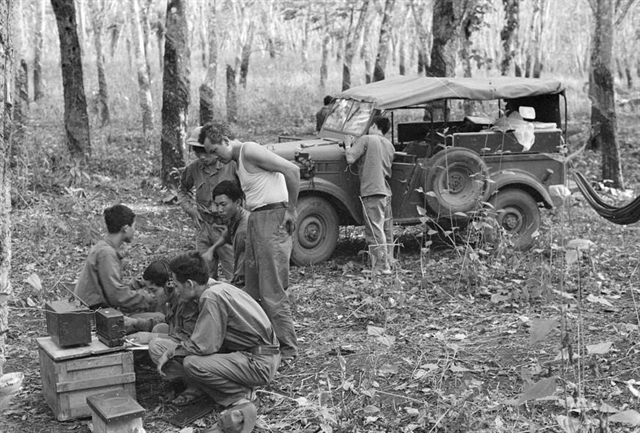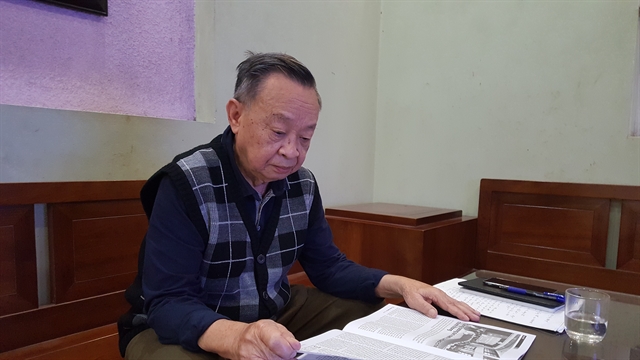 Society
Society

During the liberation struggle in the south of Việt Nam, Vietnam News Agency (VNA) reporters, photographers and technicians overcame difficulties to report on the war.

|
| Frontline VNA reporters broadcast news on the battlefield during the Hồ Chí Minh Campaign in April 1975. — VNA File Photo |
Đinh Thuận
HÀ NỘI — During the liberation struggle in the south of Việt Nam, Vietnam News Agency (VNA) reporters, photographers and technicians overcame difficulties to report on the war.
Radio engineer Phạm Lộc, former deputy director of the VNA Technical Centre, is always excited when recalling memories about his hard work to set up a standby broadcasting station in the forest and the victorious moment when he and his colleagues witnessed the south's liberation and national reunification on April 30, 1975.
Back in 1964 when the war was escalating in northern Việt Nam, following the direction of the Party and Government, the VNA was ready to relocate and prepare techniques to set up a standby broadcasting station.
Phượng Cách Commune, Quốc Oai District, Hà Tây Province (now Hà Nội) with its caves was chosen as the station’s location to avoid American bombings.
Lộc said VNA staff dug shelters in the caves and mountains to set up the station and had to move big and heavy machines by themselves into the shelters.
To install the broadcasting antenna, they had to carry sand and cement packs up Sơn Tượng Mountain.
Most of the engineers and other staff of the T6 broadcasting station were young and full of energy and kept up their enthusiasm despite the hard work, Lộc said.
Lộc, who was head of the standby broadcasting station, and his colleagues were in charge of sending VNA photos and news to VNA headquarters in other provinces and cities.
The station was also responsible for training technical workers for the south and other VNA units.
During the fight for liberation, the station officials and engineers were on duty in all localities and battlefields to keep the news flowing.
In 1973, the standby station became the VNA’s official broadcasting station.
Lộc will never forget April 1975 when he joined a group of VNA staff led by then VNA Director-General Đào Tùng including reporters Lam Thanh, Văn Bảo, Phạm Vỵ, Trần Mai Hạnh, Nguyễn Hữu Chí and technician Phạm Văn Lược to head for the south to cover the victory of the Vietnamese military and people.
On the way from Hà Nội to the south, when reaching the southern province of Tây Ninh where the Liberation Press Agency - the southern counterpart of VNA during wartime - was based, he and other engineers tried sending photos and news to the capital.
During the attack on the US-backed Sài Gòn regime, engineer Lộc trained his colleagues on new photo sending techniques that he learned overseas.
Thanks to the techniques, a larger number of photos were sent more quickly.
All this was to prepare for a big event: the south's liberation and national reunification.
The VNA was the first news agency to report about the milestone with photos taken by journalist Văn Bảo and news covered by reporter Trần Mai Hưởng.
At noon on April 30, 1975, a group of Liberation Press Agency’s staff led by director Trần Thanh Xuân moved from Tây Ninh to occupy the Sài Gòn regime’s news agency on Hồng Thập Tự Road (now Nguyễn Thị Minh Khai Street).
On the morning of May 1, engineer Lộc and reporter Phạm Vỵ were ordered by the VNA Director-General to take over the news agency.
The agency back then lacked modern machines, had only 10 teletype machines and did not have news broadcasting or photo sending equipment.
Despite difficult working conditions, they still completed their tasks to broadcast the latest news during wartime.
After April 30, 1975, Vietnam News Agency and Liberation Press Agency covered the building of a new regime and stabilising lives in newly-liberated areas.
In 1976, the VNA was merged with Liberation Press Agency to become today's Vietnam News Agency.
After the country was united, engineer Phạm Lộc and his colleagues at the VNA Technical Department, now VNA Technical Centre, worked to develop a modern technical system, contributing to elevating VNA’s prestige. — VNS

|
| VNA technician Phạm Lộc reads a VNA journal. Although he has retired, he still follows VNA news every day. —VNA/VNS Photo |